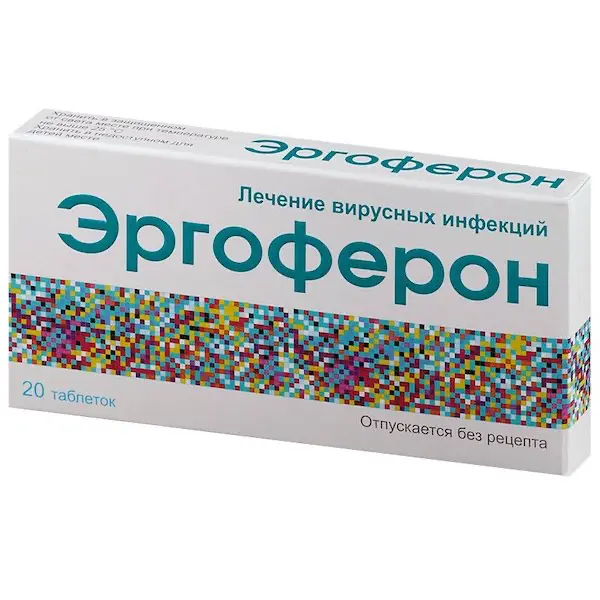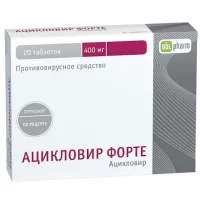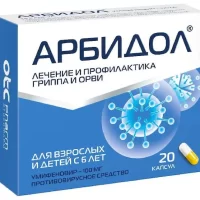Description
Ergoferon Pharmacodynamics
The spectrum of Ergoferon pharmacological activity includes antiviral, immunomodulatory, antihistamine, anti-inflammatory.
The effectiveness of Ergoferon components in viral infectious diseases has been experimentally and clinically proved: influenza A and influenza B, acute respiratory viral infections (caused by parainfluenza viruses, adenoviruses, respiratory syncytial viruses, coronaviruses), herpesvirus infections (labial herpes, ophthalmoherpes, genital herpes, herpes zoster, varicella pox, infectious mononucleosis), acute intestinal infections of viral etiology (caused by caliciviruses, coronaviruses, rotaviruses, enteroviruses), enteroviral and meningococcal meningitis, hemorrhagic fever with renal syndrome, tick-borne encephalitis.
The drug is used in complex therapy of bacterial infections (pseudotuberculosis, whooping cough, yersiniosis, pneumonia of various etiology, including atypical pathogens (M.pneumoniae, C.Pneumoniae, Legionella spp.), used for prevention of bacterial complications of viral infections, prevents superinfections. The usage of the preparation during pre- and post-vaccination period increases the effectiveness of vaccination, provides non-specific prophylaxis of acute respiratory viral infections and influenza in the period of post-vaccination immunity establishment. Ergoferon has a prophylactic effect against acute respiratory viral infections of non-flu etiology, prevents the development of intercurrent diseases in post-vaccination period. Components of the preparation possess a single mechanism of action in a form of increase of functional activity of CD4 receptor, receptors to interferon gamma (IFN-?) and histamine, correspondingly, that is accompanied by marked immunotropic action.
It has been experimentally proved that antibodies to interferon gamma:
increase the expression of IFN-?, IFN ?/? as well as conjugated interleukins (IL-2, IL-4, IL-10, etc.), improve the ligand-receptor interaction of IFN, restore cytokine status; normalize the concentration and functional activity of natural antibodies to IFN-? which are important factors of natural antiviral tolerance; stimulate interferon-dependent biological processes: the induction of expression of antigens of the main histocompatibility complex of types I, II and Fc-receptors, monocyte activation, stimulation of functional activity of NK-cells, immunoglobulin synthesis regulation, activating mixed Тh1 and Тh2 immune response.
Antibodies to CD4, probably being allosteric modulators of this receptor, regulate the functional activity of CD4 receptor, which leads to increase of the functional activity of CD4 lymphocytes, normalization of the immunoregulatory index CD4/CD8, as well as subpopulation composition of immunocompetent cells (CD3, CD4, CD8, CD16, CD20).
Antibodies to histamine modify histamine-dependent activation of peripheral and central H1-receptors and thereby reduce tone of bronchial smooth muscle, decrease capillary permeability, which leads to reduction of duration and severity of rhinorrhea, nasal mucosal edema, cough and sneezing, as well as reduction of severity of allergic reactions accompanying infectious process due to suppression of histamine release from mast cells and basophils, leukotrienes production, adhesion molecules synthesis, reduction of eosinophils chemotaxis and platelet aggregation in reactions to contact with allergen.
Concomitant use of the components of the complex drug is accompanied by an increase in the antiviral activity of its components.
Indications
- Prevention and treatment of influenza A and B.
- Prevention and treatment of acute respiratory viral infections caused by parainfluenza virus, adenovirus, respiratory syncytial virus, coronavirus.
- Prevention and treatment of herpesvirus infections (labial herpes, ophthalmoherpes, genital herpes, varicella, herpes zoster, infectious mononucleosis).
- Prevention and treatment of acute intestinal infections of viral etiology (caused by calicivirus, adenovirus, coronavirus, rotavirus, enteroviruses).
- Prevention and treatment of enterovirus and meningococcal meningitis, hemorrhagic fever with renal syndrome, tick-borne encephalitis.
- Application in complex therapy of bacterial infections (pseudotuberculosis, whooping cough, yersiniosis, pneumonia of various etiology, including caused by atypical pathogens (M.pneumoniae, C.Pneumoniae, Legionella spp)); prevention of bacterial complications of viral infections, prevention of superinfections.
Contraindications
- Increased individual sensitivity to the drug components.
- Pregnancy and lactation
- The safety of Ergoferon administration during pregnancy and lactation has not been studied. If it is necessary to prescribe the drug, the risk/benefit ratio should be taken into consideration.
Dosage and administration method
- Orally, not with meals. The tablet should be kept in the mouth without swallowing until completely dissolved.
- Children from 6 months of age. When administering the drug to young children (6 months to 3 years) is recommended to dissolve the tablet in a small amount (1 tablespoon) of boiled water at room temperature.
- On the 1st day of treatment take 8 tablets under the following scheme: 1 tablet every 30 minutes during the first 2 hours (5 tablets in 2 hours in total), then during the same day take another 1 tablet 3 times at regular intervals. On the 2nd day and further take 1 tablet 3 times a day until full recovery.
- For the prevention of viral infectious diseases – 1-2 tablets a day. The recommended duration of the prophylactic course is determined individually and may be 1-6 months.
- If necessary, the drug can be combined with other antiviral and symptomatic drugs.





